Structural inspectors and assessors are the silent heroes who deserve our respect. Their work is absolutely essential and ensures that you can live safely in your home. But what they see while on the job, while shocking, is a mystery to many.
However, Alpha Structural Inc., a Los Angeles-based company, lifts the veil and shows the reality of the job. Its employees share nightmarish and shocking photos from their assessments. Today, we’re featuring some of their most powerful pics of all time. Scroll down to check them out. If this won’t get you serious about structural safety, nothing will!
More info: AlphaStructural.com | Imgur | Facebook | X | Instagram | YouTube | TikTok
#1
Jenga! Your turn.

Image credits: AlphaStructural
#2
This 7-inch crack is showing severe signs of differential settlement, meaning portions of the foundation are sinking at a greater rate.
Foot added for reference.

Image credits: AlphaStructural
#3
This subterranean basement had a window that opened up into an open area underground. Imagine opening the window in your basement and a group of bats fly in. That probably wouldn’t happen here but it’s possible! This is a great spot for putting your disobedient kids.

Image credits: AlphaStructural
Structural inspectors do exactly what’s in their name: they inspect structures. Their goal is to see if there are any structural issues or defects that might compromise a building’s safety.
They evaluate a building’s integrity by looking at the foundations, beams, columns, posts, joints, trusses, and any other components that bear a load. A home has to be strong and rock solid, not just look nice.
#4
An unstable slope will show indications of movement by the presence of geotropism, which refers to the growth of plants against gravity. The way the trees bend towards the bottom of the slope lets us know the hillside is unstable and is constantly moving.

Image credits: AlphaStructural
#5
At least they placed the concrete on the dirt to avoid termites. 2 out of 10 for the effort.
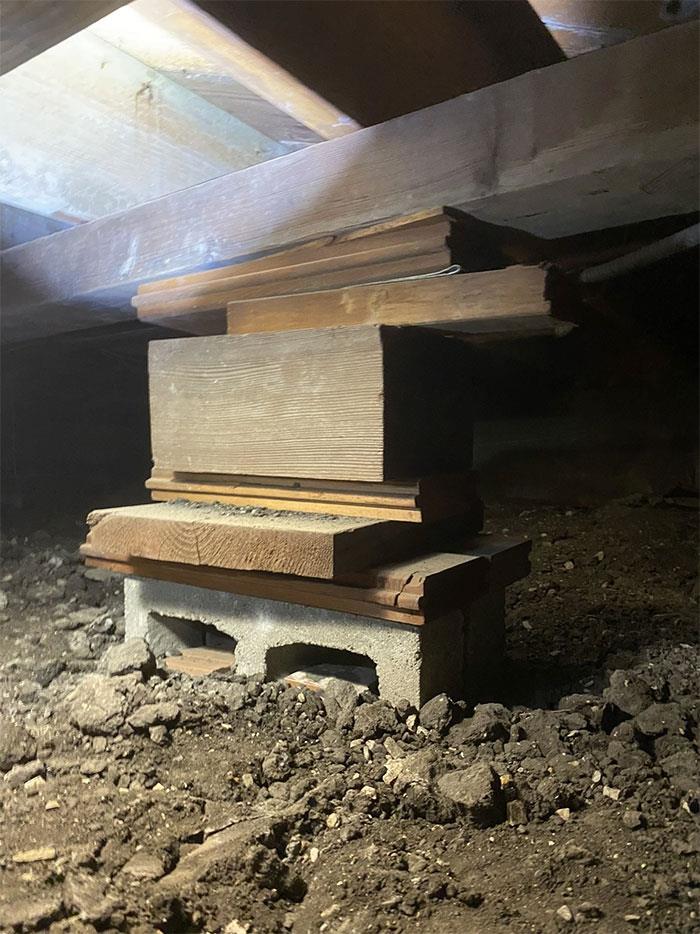
Image credits: AlphaStructural
#6
These homeowners were out of town when their pool service technician left the water running. As a result, the pool overflowed and contributed to the failure of this deck.

Image credits: AlphaStructural
You might ask for a structural inspector’s services if you’re buying a home, spot cracks in the ceiling, walls, or foundations, or have problems with the drainage on your property.
The importance of these assessments can’t be overstated: your health and even your life might be at risk if something is seriously wrong with the integrity of the building. If there’s a potential problem, and you haven’t been regularly maintaining your home, you definitely want it to be evaluated instead of praying for good luck.
#7
This Rancho Palos Verdes home is experiencing extreme settlement and shifting which is evident in the huge cracks along the exterior.
Let’s just say the bend in the roof is not architectural.

Image credits: AlphaStructural
#8
The Los Angeles hillside communities were some of the hardest hit during the storm. Hillsides all over SoCal failed and our assessors were quickly dispatched out on emergency calls.
Don’t underestimate the power of water.

Image credits: AlphaStructural
#9
This home is suffering from a severe case of fungus growth inside the crawlspace. The amount of fungus that has spread across the joists and girder can potentially be a serious issue for the homeowners.
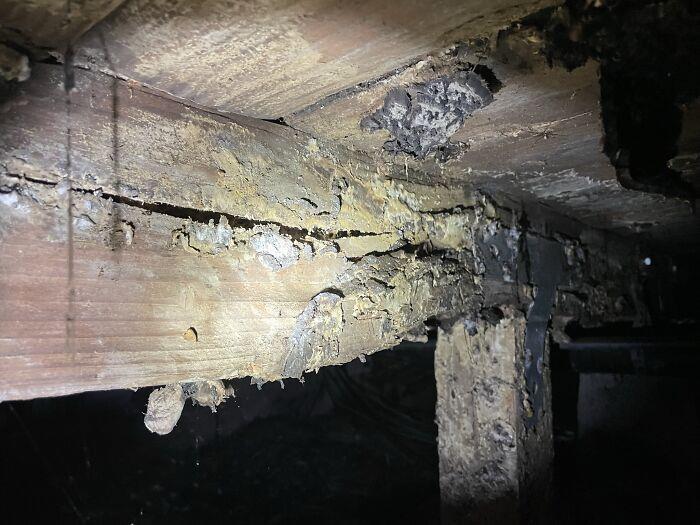
Image credits: AlphaStructural
Alpha Structural, which has been serving Los Angeles and Southern California for foundation repair since 1993, is known globally.
Not only has the company been doing stellar work for more than three decades, but it has also built up a very recognizable brand due to its prominent and iconic marketing on social media. In short, the company provides a glimpse of what it’s like to be on one of these inspections.
#10
The main support beams for this stilt home are suffering from extreme wood rot.

Image credits: AlphaStructural
#11
Interesting brickwork on that chimney you got there.
Tell me you love controlled chaos without telling me you love controlled chaos.

Image credits: AlphaStructural
#12
Sometimes the access points to these crawlspaces can be a bit rough…

Image credits: AlphaStructural
It’s very likely that you’ve seen the business’ posts on Imgur, Facebook, X (formerly Twitter), or Instagram. Or maybe you’ve seen some of their clips on YouTube or TikTok. In short, Alpha Structural inspectors share some of the most impressively horrifying shots from their assessments online.
They’re captivating because they show the potential for danger. Not only that but some of the things that the inspectors find are truly mind-bogglingly creepy, from skulls to dolls.
#13
Please watch your step!
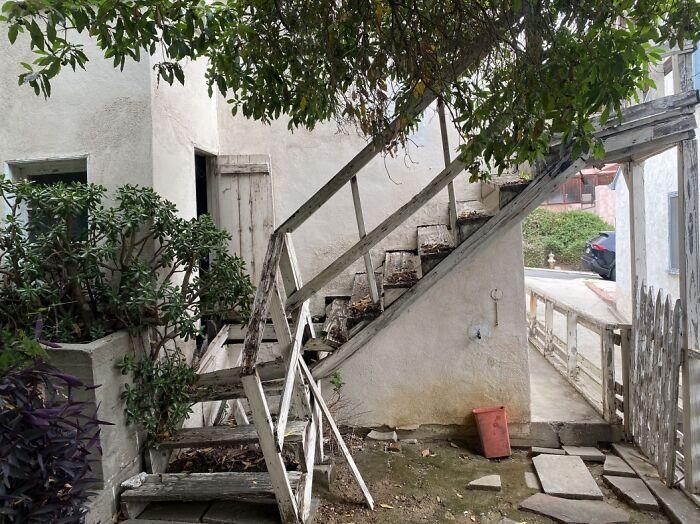
Image credits: AlphaStructural
#14
Here we have a brick retaining wall experiencing surcharge from the neighboring hill. Structures that are settling can cause this surcharge in the soil. This creates a high-pressure situation which then pushes out the remaining soil and results in this type of damage to retaining walls.

Image credits: AlphaStructural
#15
Being that my company in LA does this sort of repair/prevention work, this was some scary news to see this morning. Torrential rain and debris caused a large chunk of Highway 1 on the West Coast of California to wash away.
You’re going to need yourself a Yoshi if you’re wanting to cross here. Back in 2017, a massive landslide covered up over a half mile of the road. It took months to clean up and there was no access around it. If it continues to rain, I wouldn’t be surprised if more of this happened in and around Southern California.
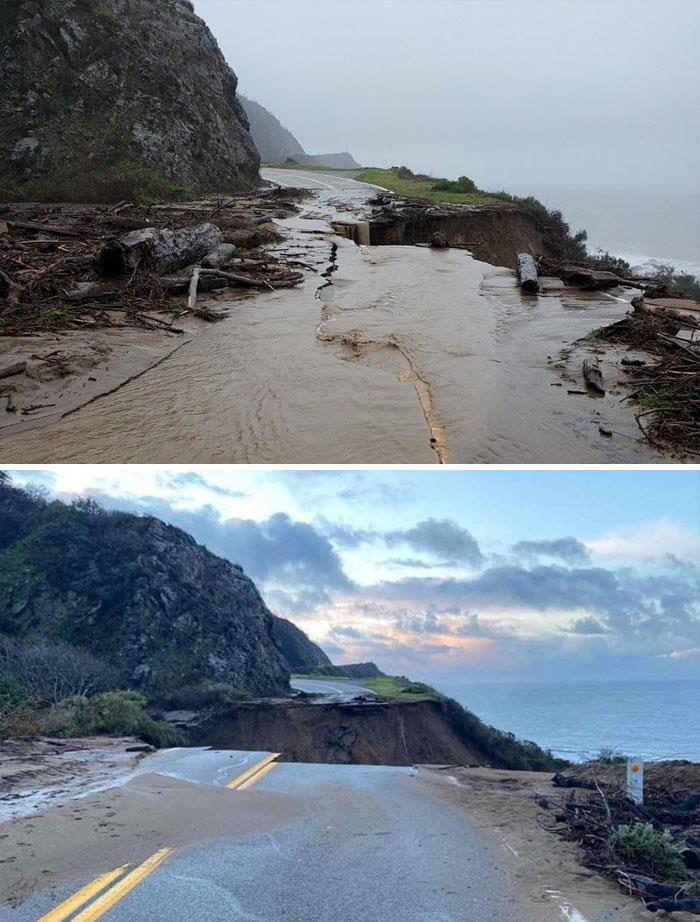
Image credits: AlphaStructural
A representative of Alpha Structural previously explained to Bored Panda during an interview that there are many different factors that can affect the repair of a home. These range from budget constraints and timing to the accessibility of workspace.
There are tons of potential problems that homeowners might not even be aware of because they simply trust their contractors to get the job done. That’s why it matters a lot that you hire contractors who have lots of experience and great skills. They might be costlier, but it’ll save you a lot of frustration in the future.
#16
I guess the original builder of this property chose the ancient Roman vibe for this foundation.
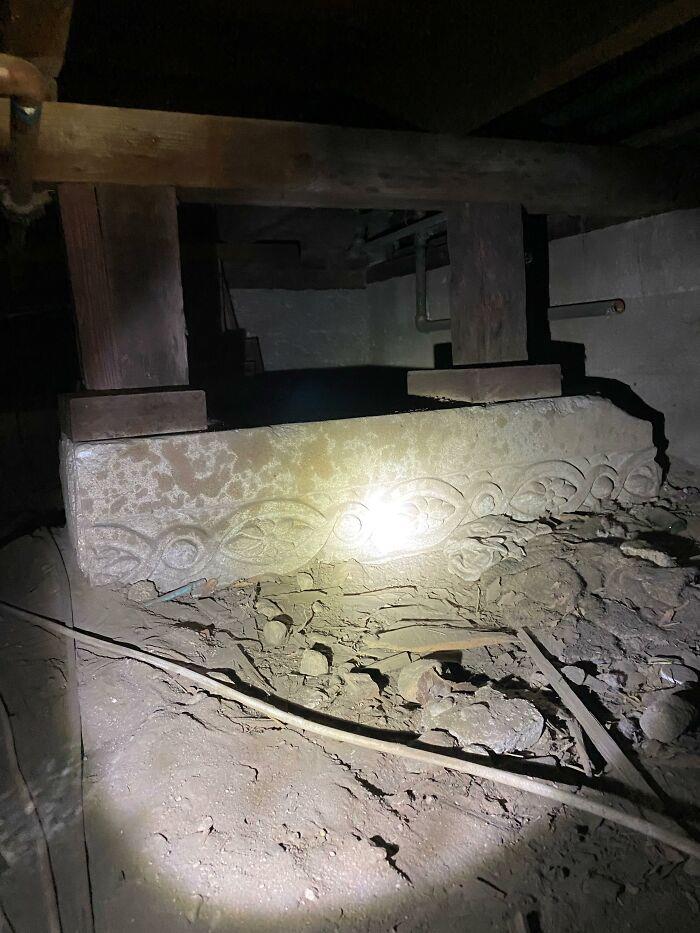
Image credits: AlphaStructural
#17
Notice the compression of the posts into the girder. They go into the girder about an inch. This property has some crazy settlement and moisture problems
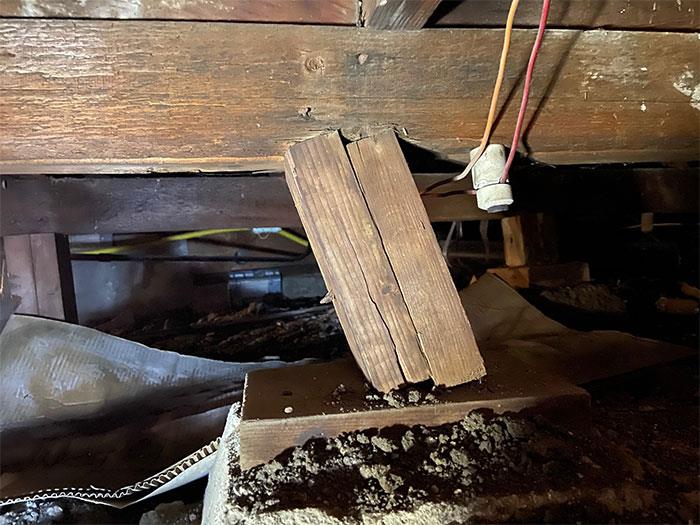
Image credits: AlphaStructural
#18
This is one of the craziest things that we’ve seen during our inspections. This owner had undermined almost the entirety of his home by digging underneath the slab and excavating around the piles. There had been a minor mudslide and they decided it would be a good idea to create more space underneath… The grade of soil used to be up to the concrete slab above. Believe it or not, the property had not yet been red-tagged.

Image credits: AlphaStructural
“For the most part, we would put the responsibility on the contractors that were hired to do the work. Most homeowners are not aware of the repair ‘methods’ used, especially when the work is under the home. For example, we’ve seen brick foundations that have been ‘retrofitted’ by bolting the framing to the brick walls. However, this doesn’t serve any purpose as the bricks can’t hold these bolts,” they told us.
“Many times, the homeowner had no idea that there was any problem performing this type of retrofit on a brick foundation. Without trying to sound cliché, we can say the old maxim ‘you get what you pay for’ holds true when selecting a contractor to repair or upgrade your home’s foundation.”
#19
This was a crazy bridge structure we saw across from a home we inspected. Many of the supporting posts are bending as the soil erodes and the structure above begins to move.
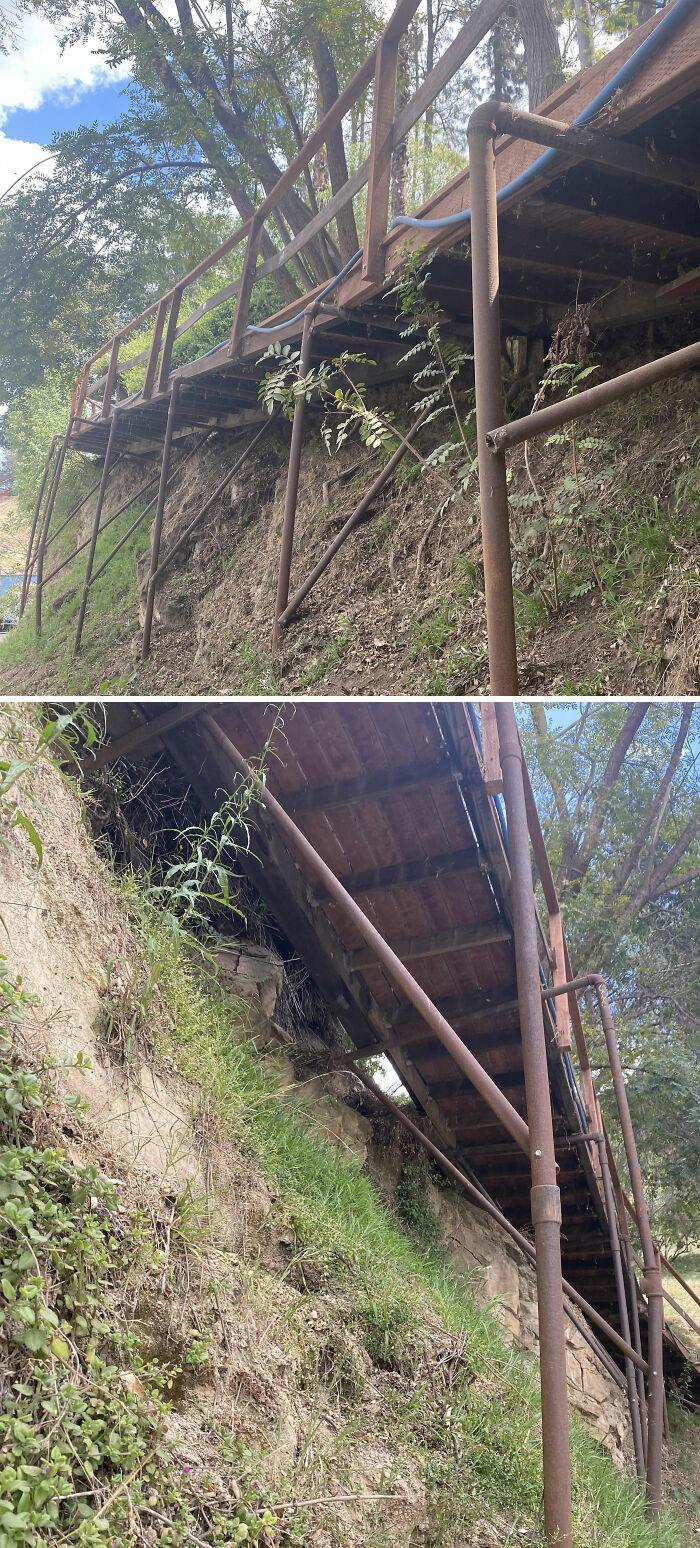
Image credits: AlphaStructural
#20
“How do you know if your wood is rotting?” This is how.

Image credits: AlphaStructural
#21
This is a cripple wall that is bowing outward, causing movement in the units above. This is dangerous and could end in a collapse if not handled properly.
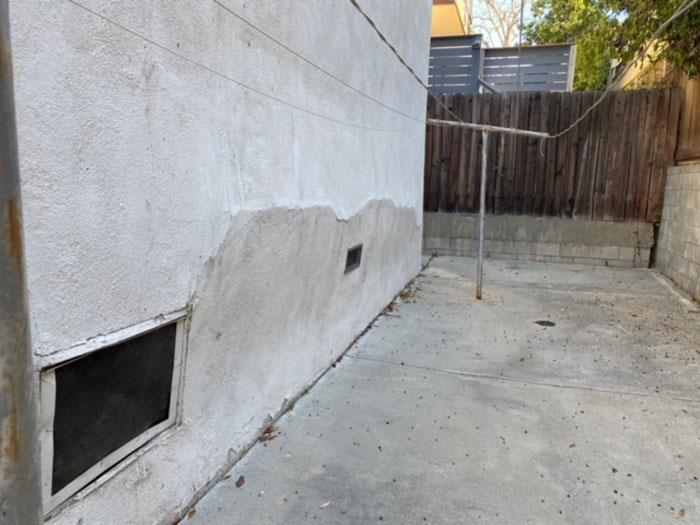
Image credits: AlphaStructural
Ben Reinhart, from Alpha Structural, opened up to Bored Panda earlier about one of the worst buildings that they’d encountered. “We went to a 3-story hillside home located in Playa del Rey. The condition of the soil supporting the home was so bad that, during our assessment, we found that the home was cracking and actually moving. We are not alarmists in any sense, but this was the first time we had to evacuate,” he said.
#22
Anyone want to step foot on this balcony?

Image credits: AlphaStructural
#23
If you wanted a visual representation of what evil looks like, this is it. And the brick foundation is in really bad shape…

Image credits: AlphaStructural
#24
We have inspected this home a few times. It’s a vacant lot, currently up for sale.
It has been like this for quite some time and should somebody buy the property, they would be in for a nice replacement project.
Here’s the side of the home where you can see a decently sized crack separating the failed and stable areas.
Nature is taking over where this retaining wall has cracked and displaced.

Image credits: AlphaStructural
“Temporary shoring was put in the next morning to prevent the home from collapsing. The complexity of the repair required, getting a large rig on a steep hillside to excavate a 55’ deepened foundation, made this one of the worst and most challenging in our long history. Let’s just say if we were on a reality TV show, this episode would’ve been a season finale.”
#25
Jenga: House Edition.

Image credits: AlphaStructural
#26
This is one of those houses you don’t want to be under for a very long time… All of the cripple walls and post and piers were tilting and the house was a solid wind gust away from collapsing. We really don’t know how it didn’t collapse in the last earthquake here in LA. There’s one thing for sure, it probably will in the next one.
Here’s one of the corners of the home. This place is a ticking time bomb.

Image credits: AlphaStructural
#27
This is the result of a creeping hillside and shallow pile placement.
As the hillside slowly moves down or “creeps”, the concrete piles, retaining walls and their footings begin to go down with it. This is why proper bearing material should be reached for all supporting systems on a hillside. Some places only require 5 feet down, others require 45+ feet down. It is imperative to get the proper depth!

Image credits: AlphaStructural
According to Alpha Structural, basic maintenance should keep a home strong for a long time to come. “Our advice would be to clean out gutters, ensure you have downspouts that direct water away from your foundation, and see that the hardscape (walkways, patios, etc.) and landscape grade away from the home,” they said.
“Most foundation problems are caused by water and poor drainage. If you look under your home, check to see that there is no earth-to-wood contact. Not only will moisture from the ground get to the wood and cause rot, but it also allows for wood-destroying organisms to get into the framing of your home. Additionally, earthquake retrofitting is a cost-effective upgrade encouraged by not only engineering communities but also local and state officials.”
#28
One good look at this photo and you’ll see multiple things going on. The floors are sloping (and have been for quite some time) so bad that it is effecting the levelness of the lamp, desk, drawers, AC vents and door frames. This home has some of the craziest sloping floors that we’ve seen.

Image credits: AlphaStructural
#29
We inspected this “dangerous” retaining wall in Los Angeles that is leaning and broken apart. You can see how bad it’s actually leaning from this angle. It has been there for quite some time but nobody has done anything to repair or replace it.

#30
Wrapping this cracked concrete column with duct tape seemed to be a good solution to this homeowner!
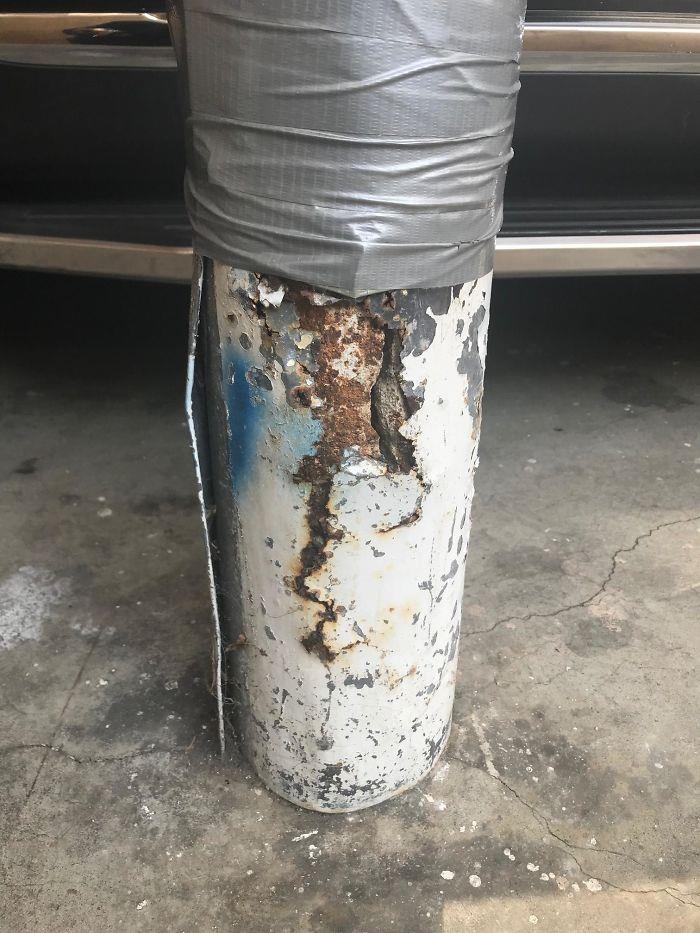
Image credits: AlphaStructural
Have you ever had to hire a structural inspector or assessor, Pandas? What’s the worst damage you’ve personally ever seen done to a building’s foundations? Which of the photos in this post shocked you the most?
If you’re in the mood to be social, scroll down to the comments and share your thoughts with everyone else!
#31
This was taken during one of our structural inspections in North Hollywood. It’s gonna take a little more than duct tape to fix this one.

Image credits: AlphaStructural
#32
We’ve seen a few dolls under homes before, but this one may take the cake on the creepiest one so far.
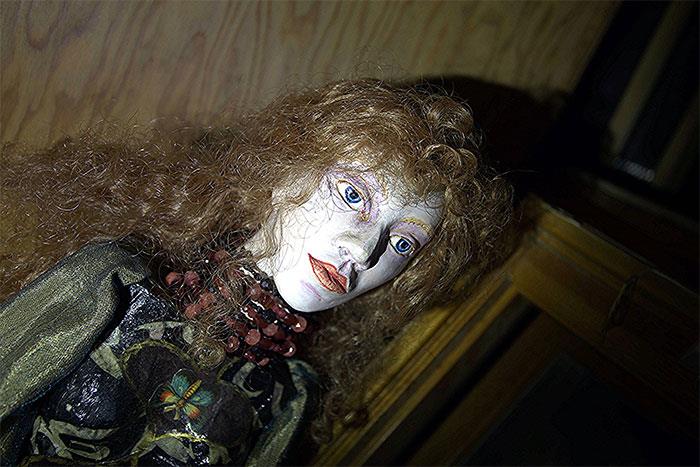
Image credits: AlphaStructural
#33
When you gotta go… you gotta go.

Image credits: AlphaStructural
#34
What seems to be the issue?
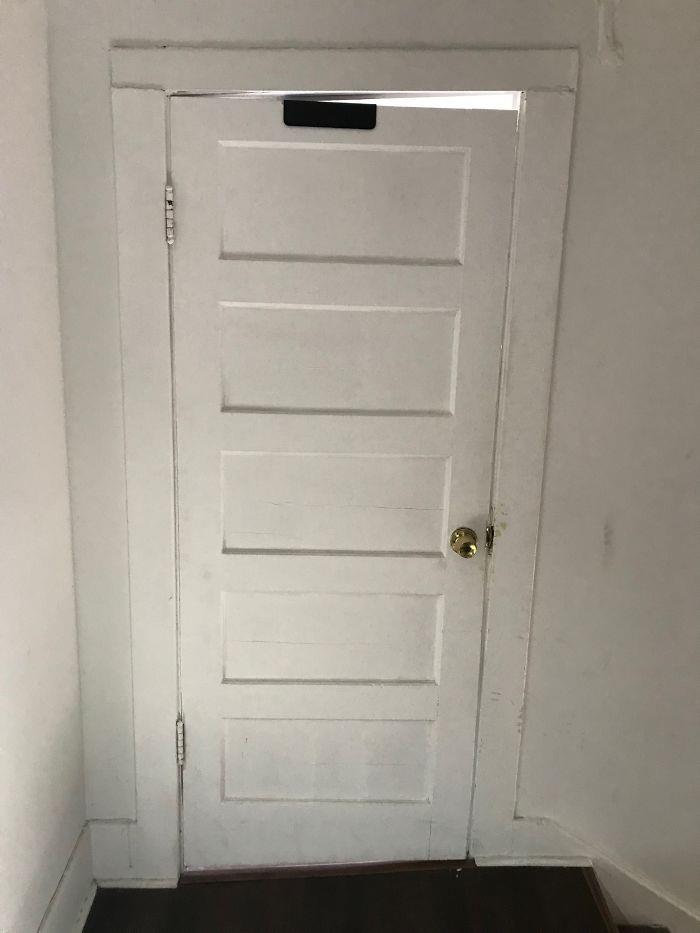
Image credits: AlphaStructural
#35
Jenga? Who wants to play?
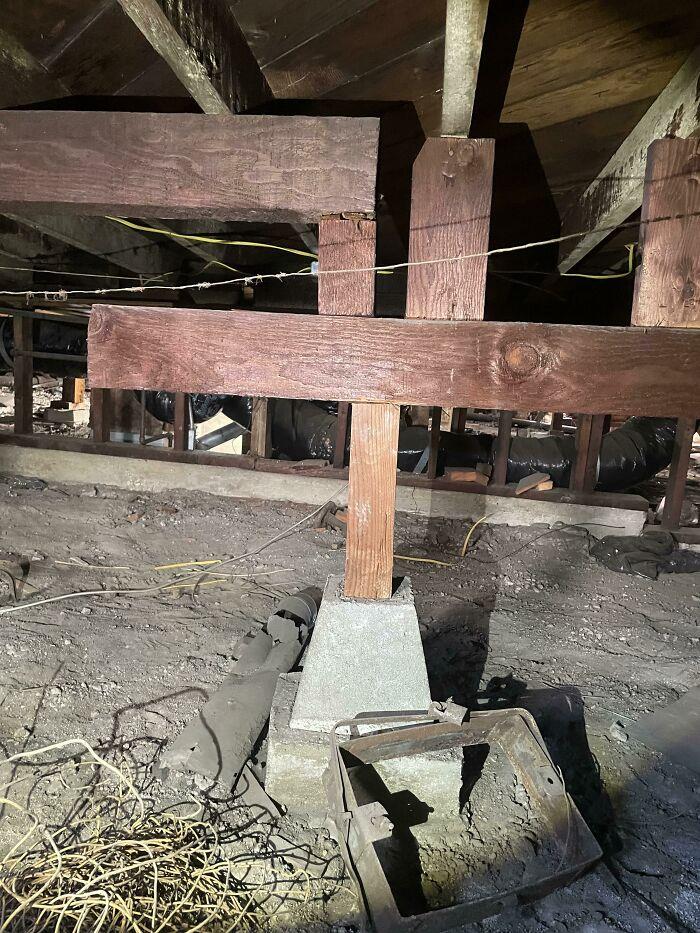
Image credits: AlphaStructural
#36
The “Balcony Bill” was signed back in 2018, and for good reason. Let’s get them up to code now.

Image credits: AlphaStructural
#37
I love magic shows.
This house impressed me with floating posts and invisible piers.

Image credits: AlphaStructural
#38
You are looking at the worst framing rot that we have ever come across on an inspection.
You can’t even touch this wall without the whole thing falling apart. Just look at the insulation around it!
You know it’s really bad when the studs begin to look like fractured vertebrae.

Image credits: AlphaStructural
#39
Hmm, did they drink a bit too much and forgot to pour the footing?

Image credits: AlphaStructural
#40
The pig from the three little pigs story did a better job at building a house of bricks.
This looks rushed. Maybe the big bad wolf was closer than they thought.

Image credits: AlphaStructural
#41
They did not understand the assignment.
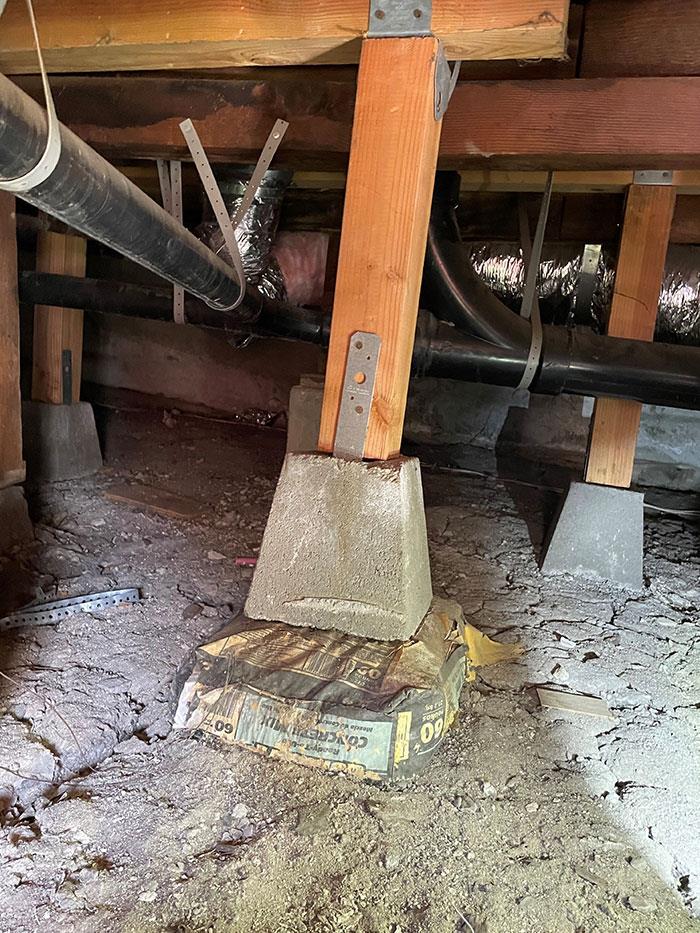
Image credits: AlphaStructural
#42
This apartment complex’s tucked-under garage has begun to spall.
Spalling can cause serious injuries as it can damage the whole structure to a point of failure.
There are three stories above this garage.

Image credits: AlphaStructural
#43
Santa better have insurance.

Image credits: AlphaStructural
#44
The foundation of this home has literally snapped in half resulting in extreme shifting throughout the structure.

Image credits: AlphaStructural
#45
We were called out to assess a failing deck on an ocean-front home, but the ocean had other plans.
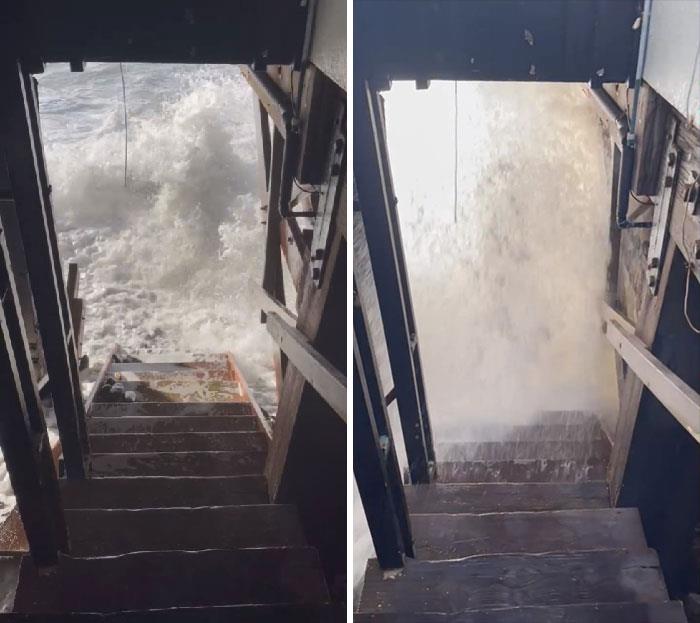
Image credits: AlphaStructural
#46
Who else is bummed they missed this party?

Image credits: AlphaStructural
#47
These posts are waiting to fall over any day now.

Image credits: AlphaStructural
#48
Another failing railroad tie “retaining wall” that should be replaced soon. You can see how far it has begun to lean towards the street.

Image credits: AlphaStructural
#49
Jenga but 100x bigger!

Image credits: AlphaStructural
#50
Still selling for one million dollars…
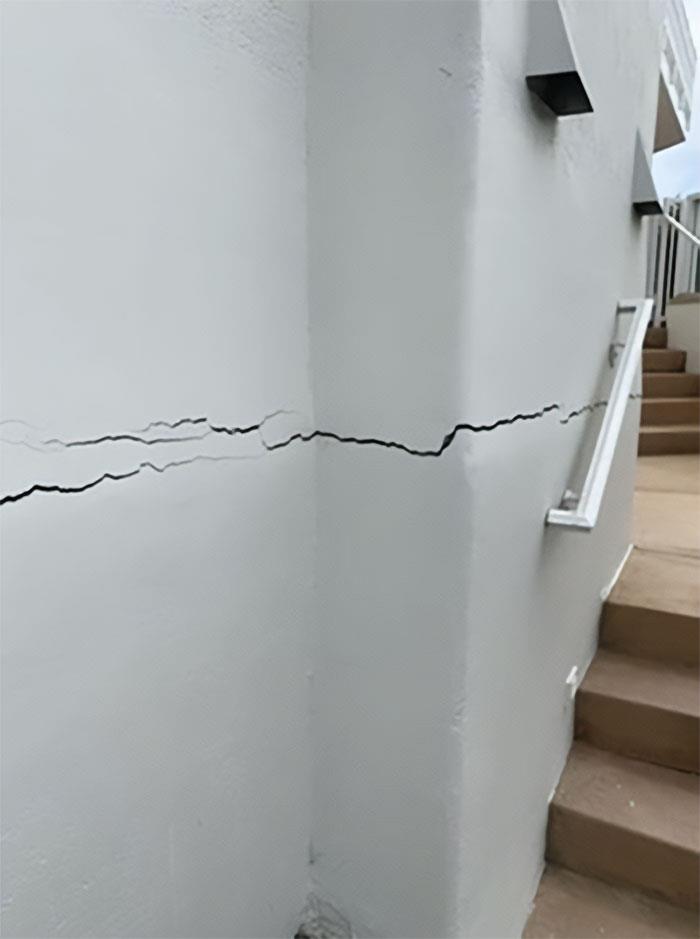
Image credits: AlphaStructural
#51
A car jack used as a subfloor support underneath a home. Classic!
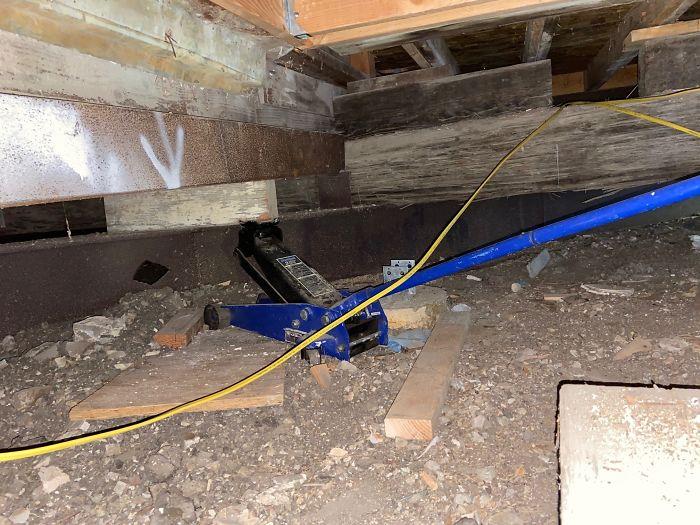
Image credits: AlphaStructural
#52
Signs of slab damage are important to assess and handle as soon as possible.
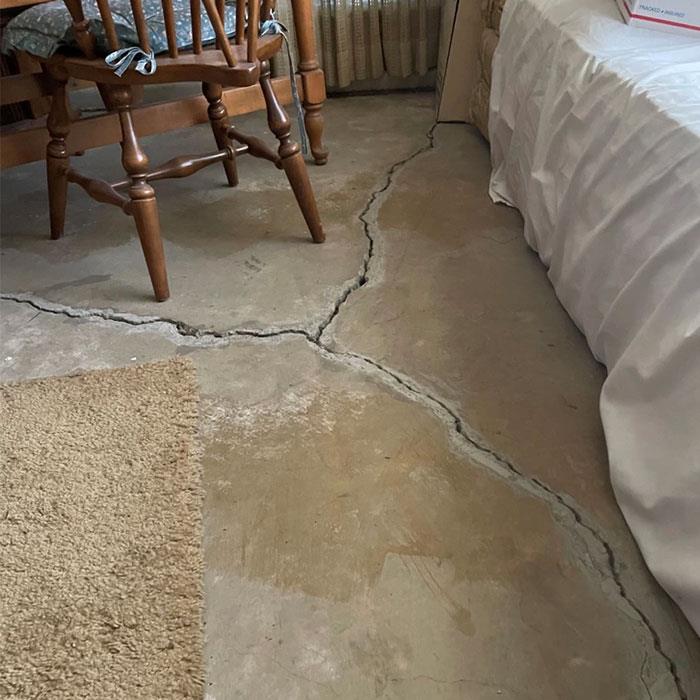
Image credits: AlphaStructural
#53
Life always finds a way…

Image credits: AlphaStructural
#54
We always seem to find very old but interesting items when working under homes in LA. Some stuff here dates back to the very early 1900s!

Image credits: AlphaStructural
#55
You know your hillside has significantly eroded when the concrete pad which was once embedded into the ground is now dangling a foot in the air.
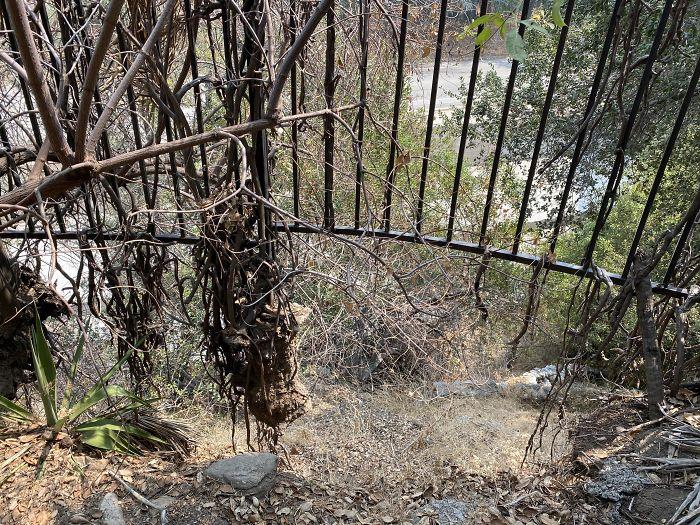
Image credits: AlphaStructural
#56
I am assuming a big rock fan lived down here!

Image credits: AlphaStructural
#57
This was a property built in the late 1940s by a guy who used to build barracks for the US Army. The home was sitting on metal I-beams and they were supported by large concrete piles. The home hasn’t moved an inch since being built. Very interesting and impressive!

Image credits: AlphaStructural
#58
Structural support shouldn’t be a balancing game.

Image credits: AlphaStructural
#59
This is a failed retaining wall. The owner just wanted some posts to put in place for reinforcement of the wall, but that is a very minor and temporary solution. Unfortunately, the wall needs to be demolished and redone.
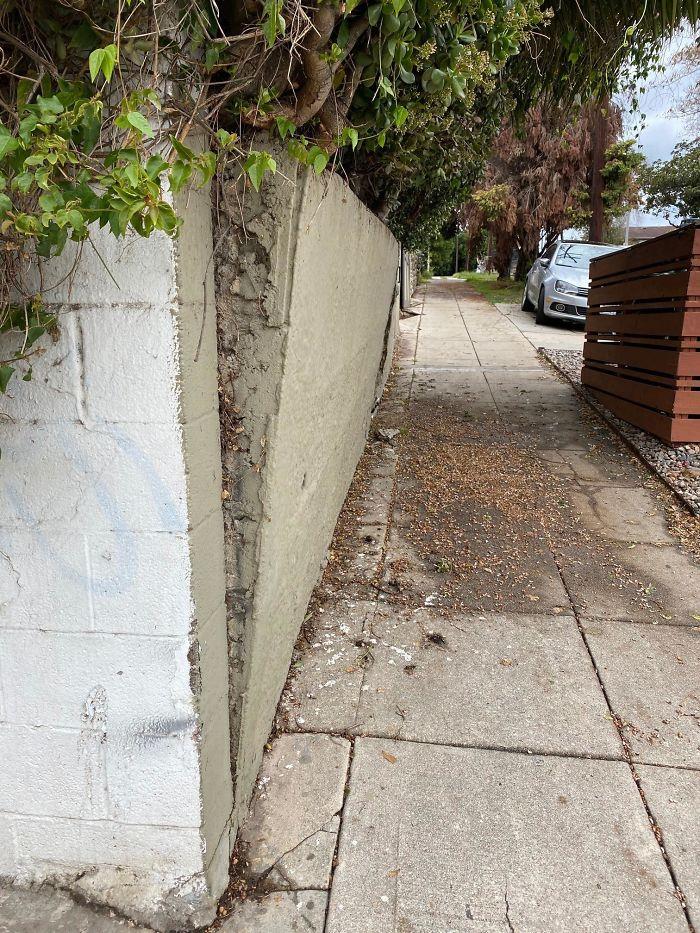
#60
“I’m on the edge” – Lady Gaga

Image credits: AlphaStructural
#61
This is one of the most interesting things we’ve inspected in almost 3 decades. This property is located in an area called the Portuguese Bend on the Palos Verdes Peninsula. This home requires some serious work. This is called cribbing. It’s a form of shoring that is used mainly for lifting a structure for a short time to perform work underneath. It is NOT meant to be a long term solution for a foundation.
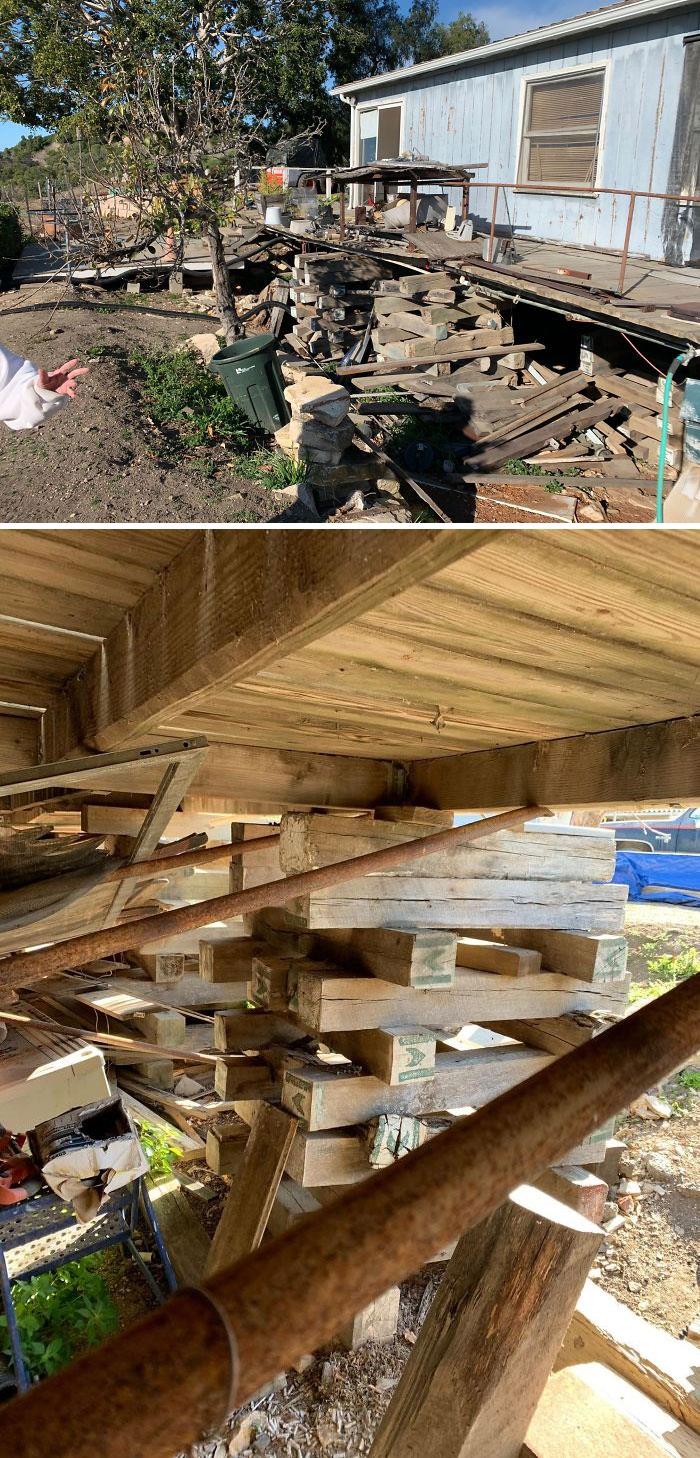
Image credits: AlphaStructural
#62
Here is one of our Senior Structural Assessors, Kyle, inspecting a failed retaining wall. You can see the tie-backs used to hold the retaining wall upright didn’t work out too well.
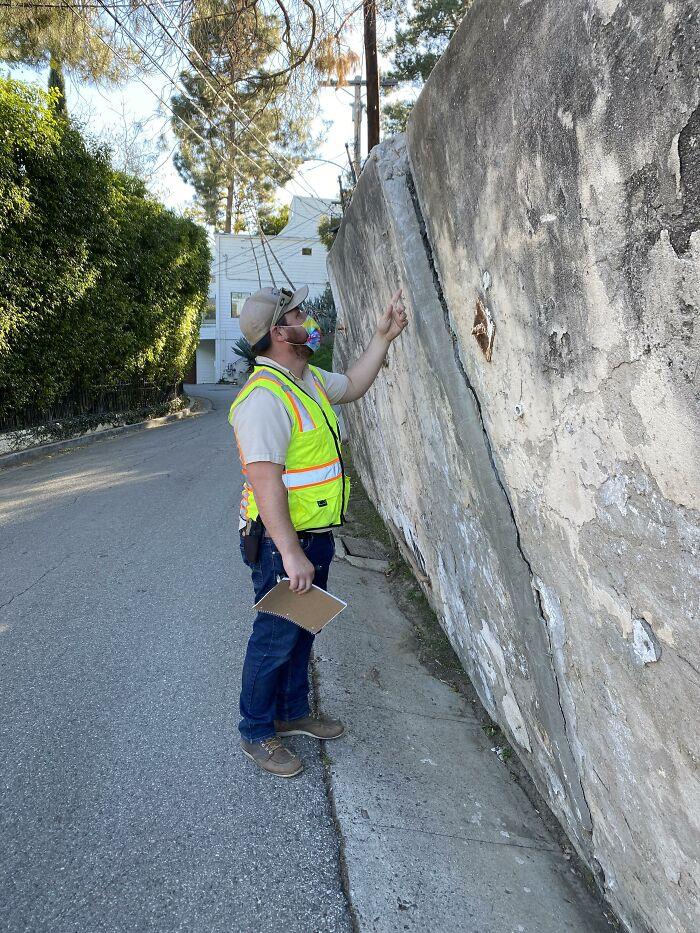
Image credits: AlphaStructural
#63
I guess they wanted an open floor plan? They took the brick wall separating the two rooms down. No permits, no contractor, just a man and his trusty hammer.
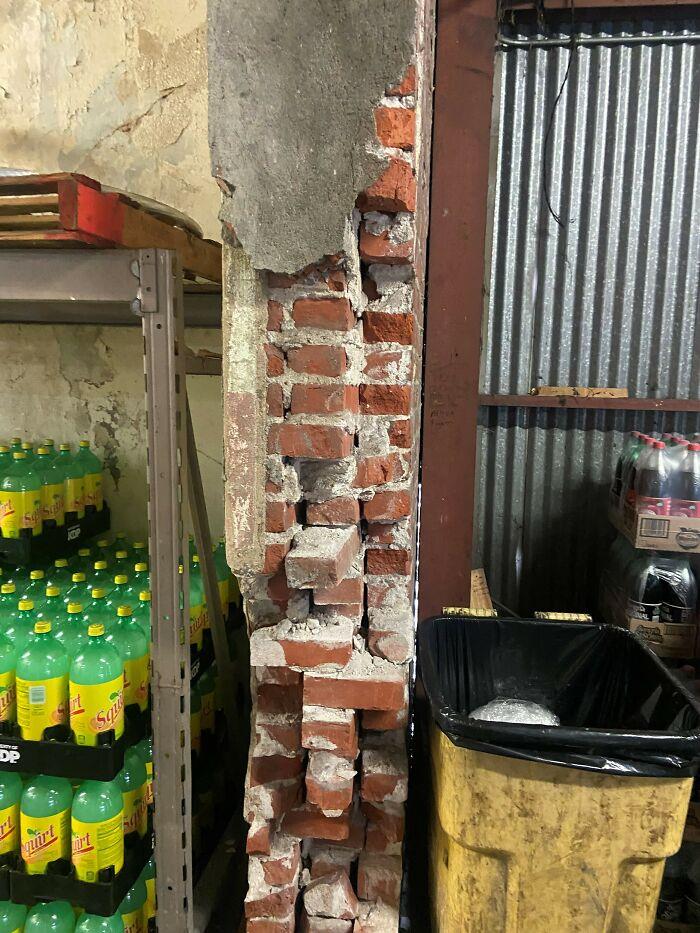
Image credits: AlphaStructural
#64
The brick and mortar piers are literally turning into dust. Not something you want holding up your entire house.
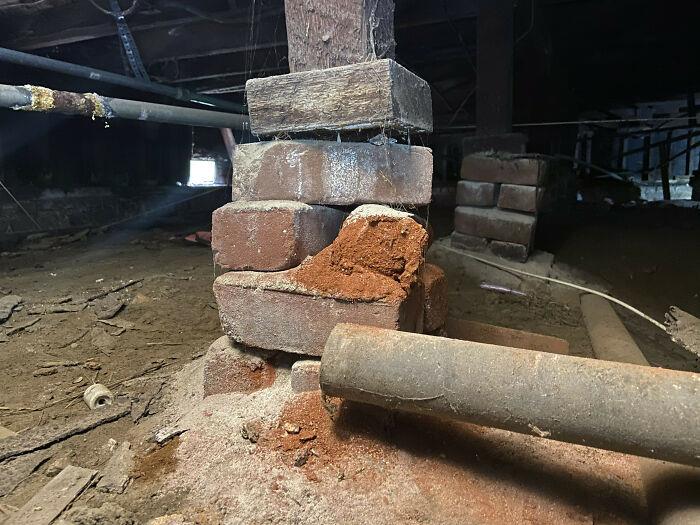
Image credits: AlphaStructural
#65
I don’t know about you but I would want to park the furthest away from this wall…
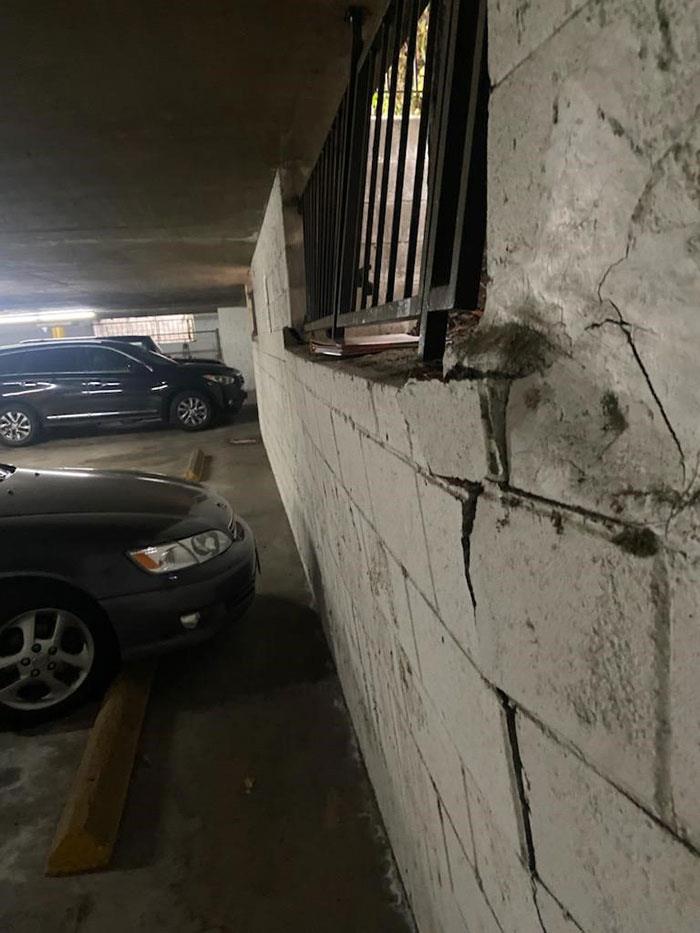
Image credits: AlphaStructural
#66
The column was barely hanging together with just a small portion of the top and bottom staying connected.
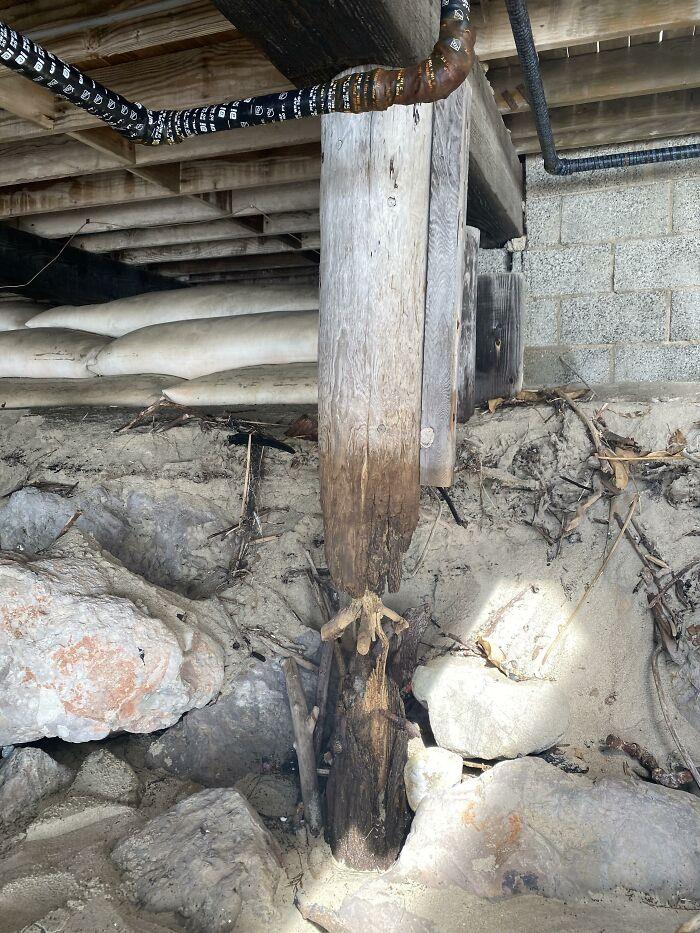
Image credits: AlphaStructural
#67
Do not jump on this deck if you enjoy living. Don’t even walk for that matter.
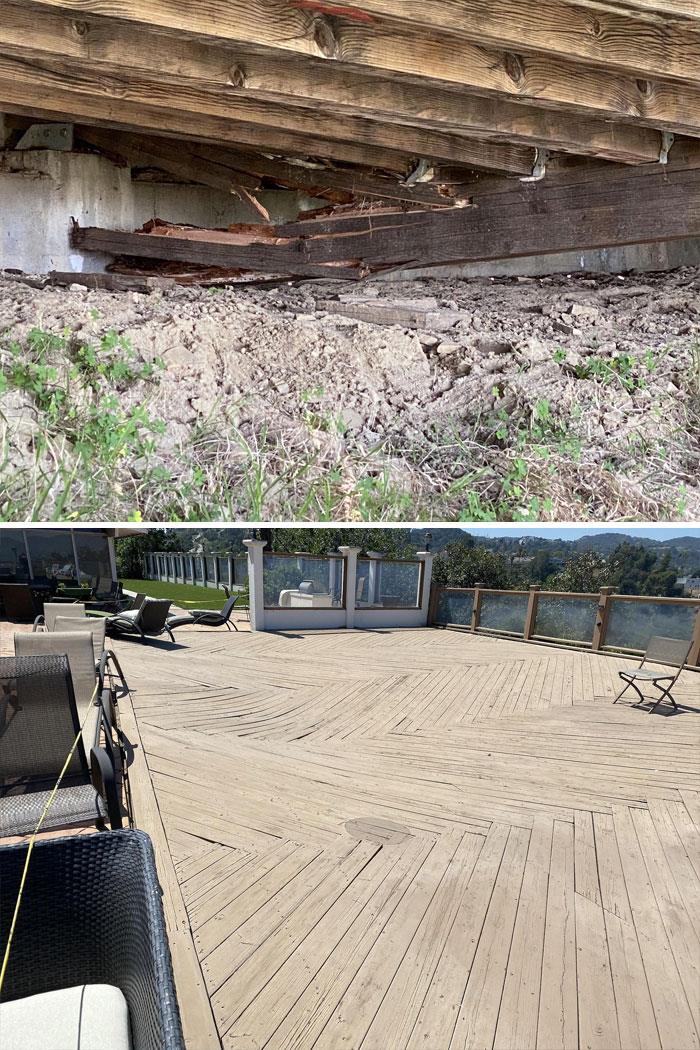
Image credits: AlphaStructural
#68
This is a pretty wicked stilt home we inspected this past week. Retrofitting these for earthquakes is one of our many specialties.
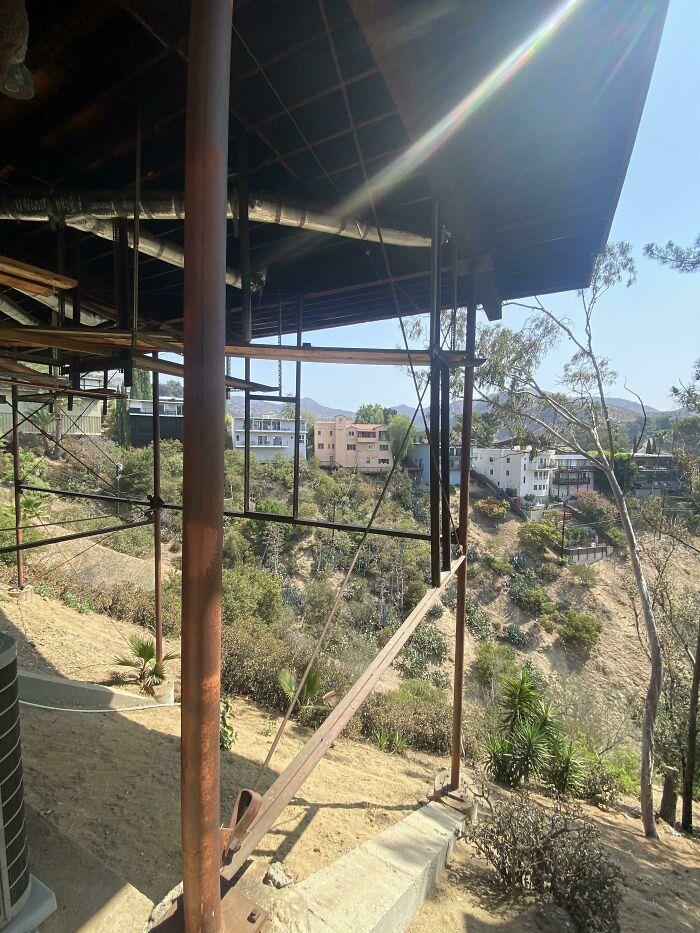
Image credits: AlphaStructural
#69
There should not be a space here. Never good news when you see stem walls separating at the corner.
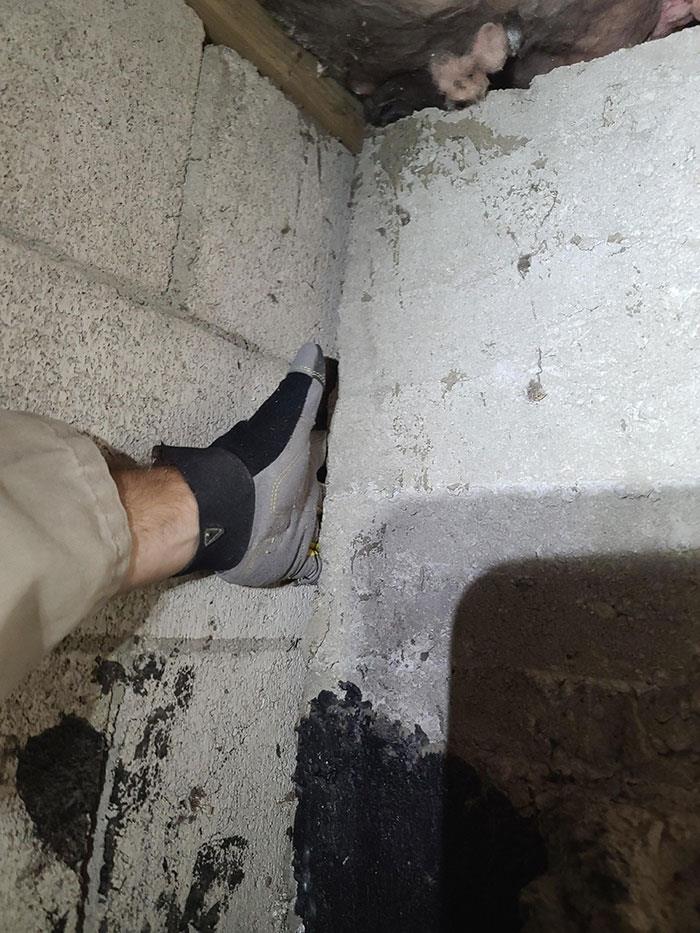
Image credits: AlphaStructural
#70
If you don’t know what termite damage looks like, here is a great example. If you notice this around your house, I would call a termite guy right away.
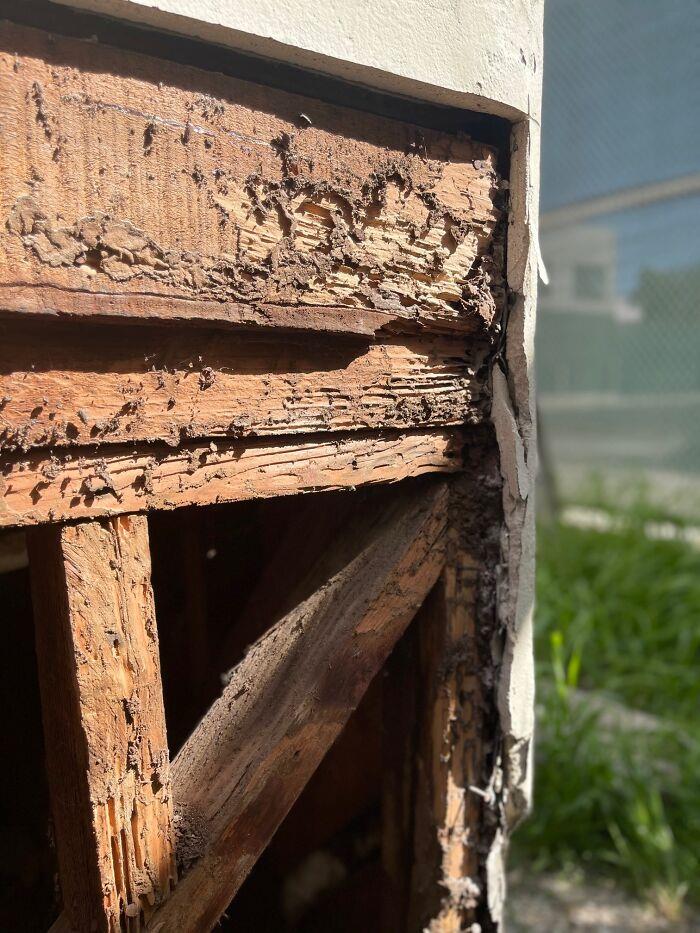
Image credits: AlphaStructural
#71
Pottery can be a very useful tool.

Image credits: AlphaStructural
#72
Almost all of the concrete piers under this home were in this condition. One solid kick and they would all be toast! They need a good replacement.
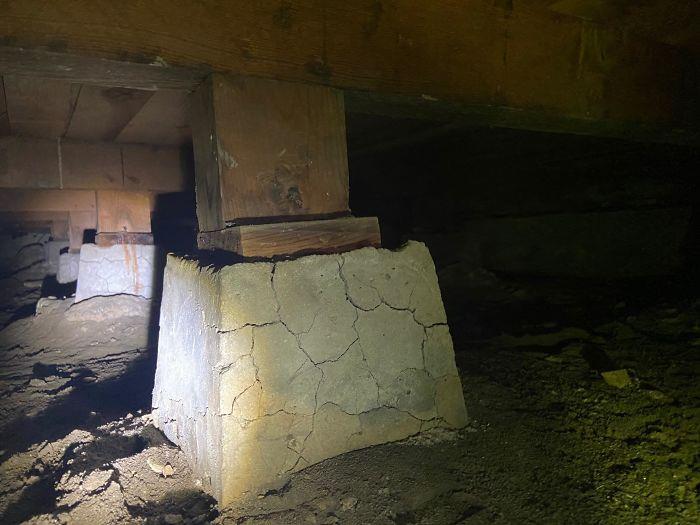
Image credits: AlphaStructural
#73
Somebody was preparing for the zombie apocalypse or something!
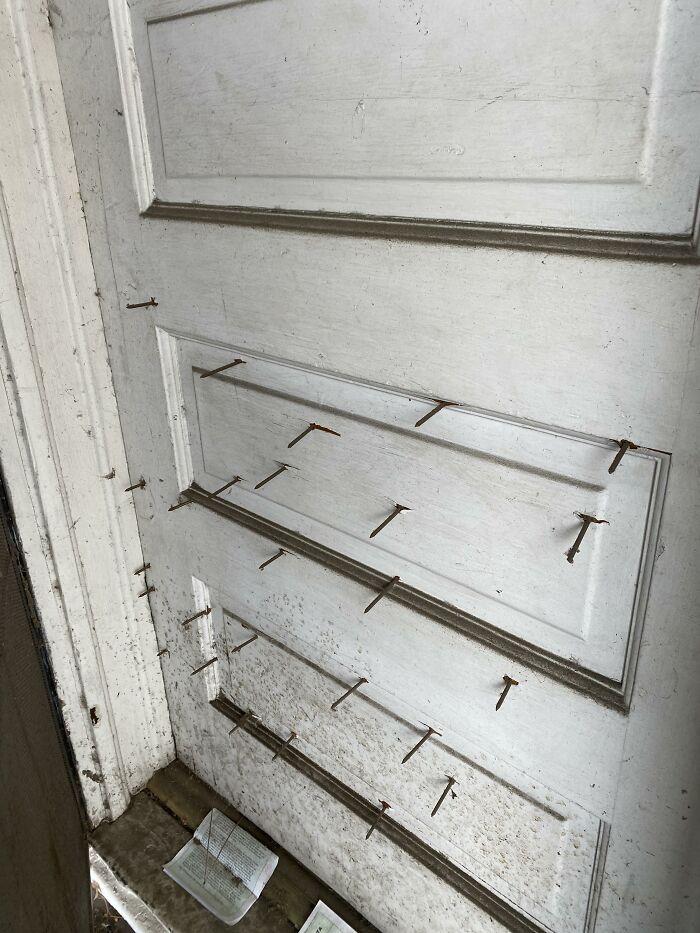
Image credits: AlphaStructural
#74
The side of this property is sinking, causing this column to lean backward, bringing the connecting beam forward in the other direction. It could slip in the future if it goes unhandled.
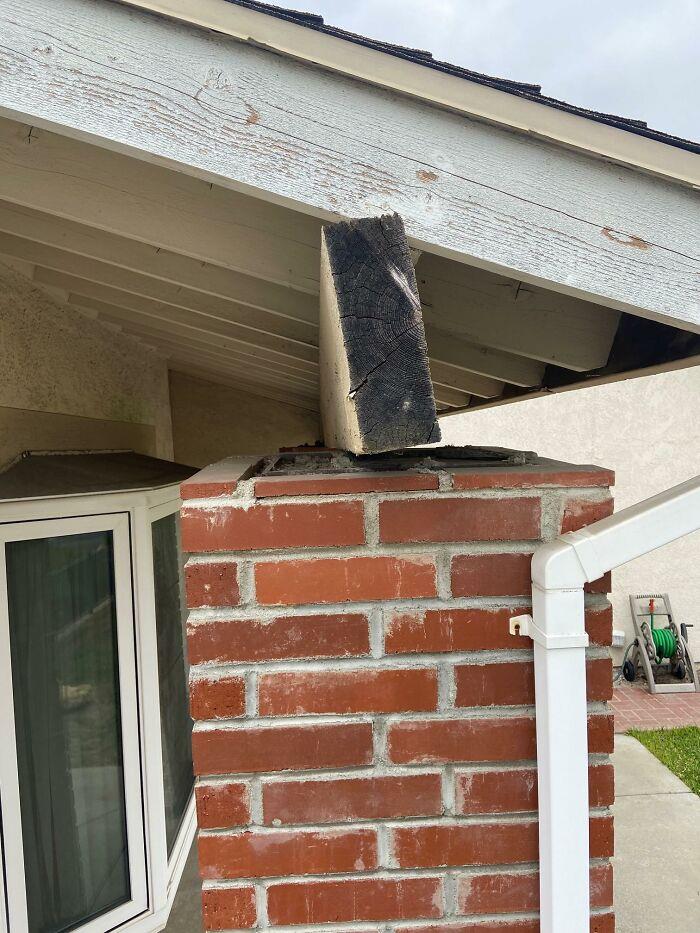
Image credits: AlphaStructural
#75
This concrete patio is sitting on a retaining wall that has been pushed outward due to what is known as a surcharge, or hydrostatic pressure build-up. Hollow areas formed under the patio, causing the cracking and further sinking of the patio from the roof load above
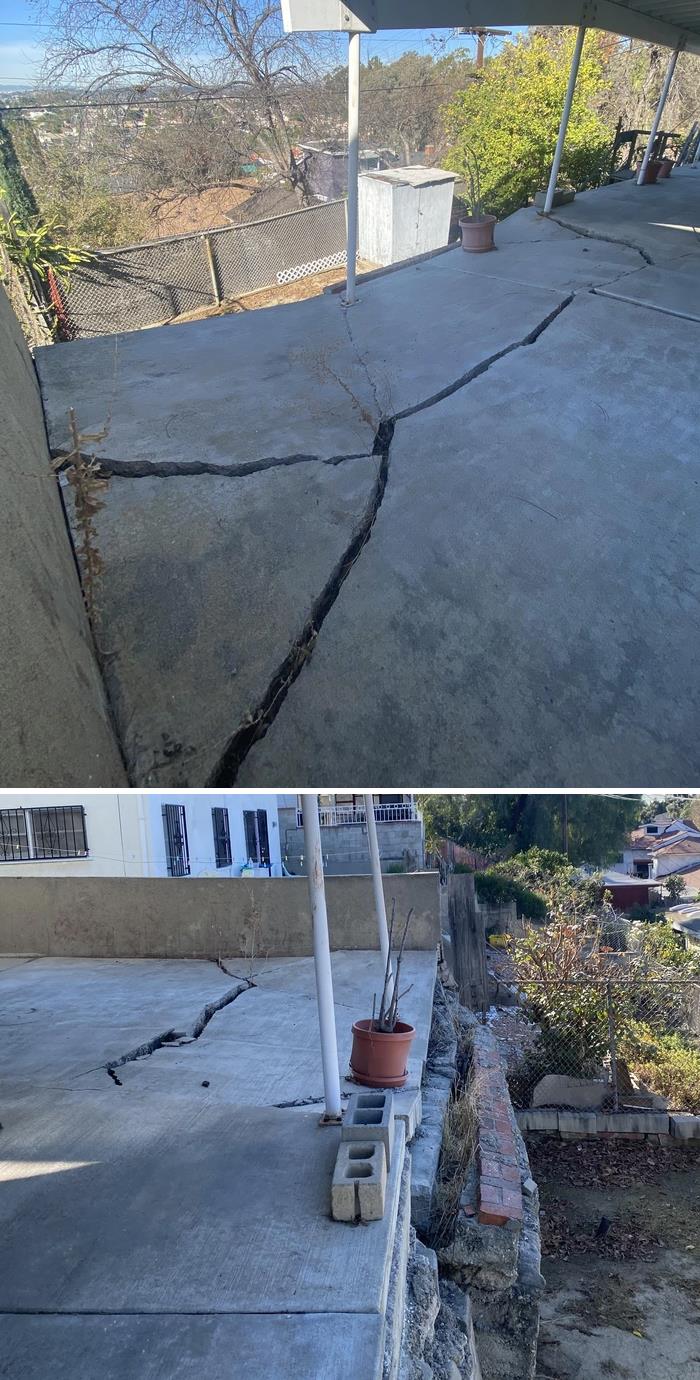
Image credits: AlphaStructural
#76
Please watch your step!
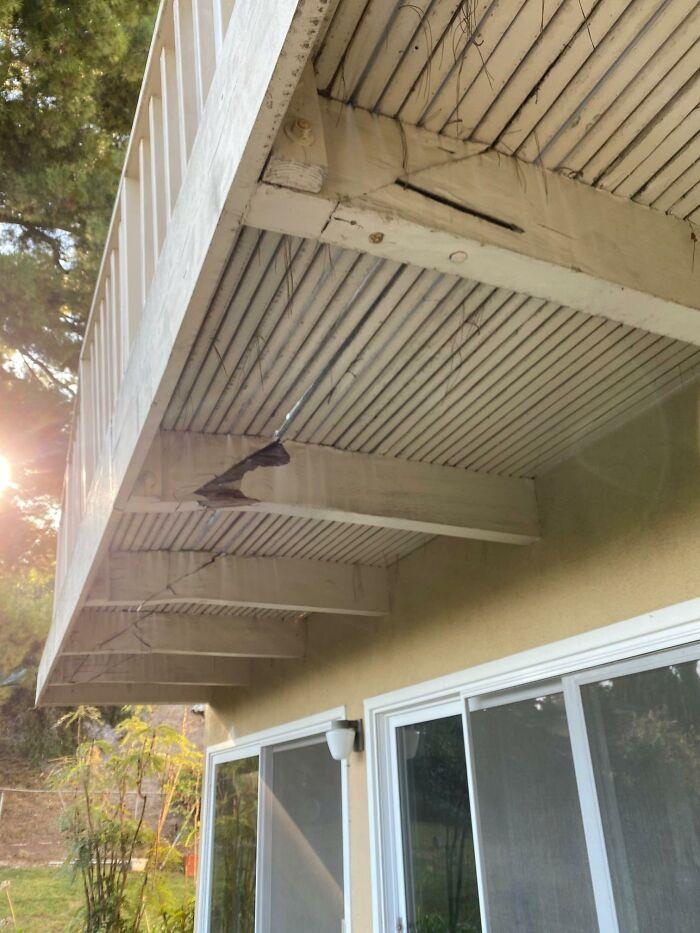
Image credits: AlphaStructural
#77
We think this takes the cake. This is not rebar. These are old Helical Piers from the 70s. It has never been a method that we have used as a company and this is why. They are very practical in many situations, but for steep hillside and seismic zones, they are not. We’ve seen this all too many times in LA.
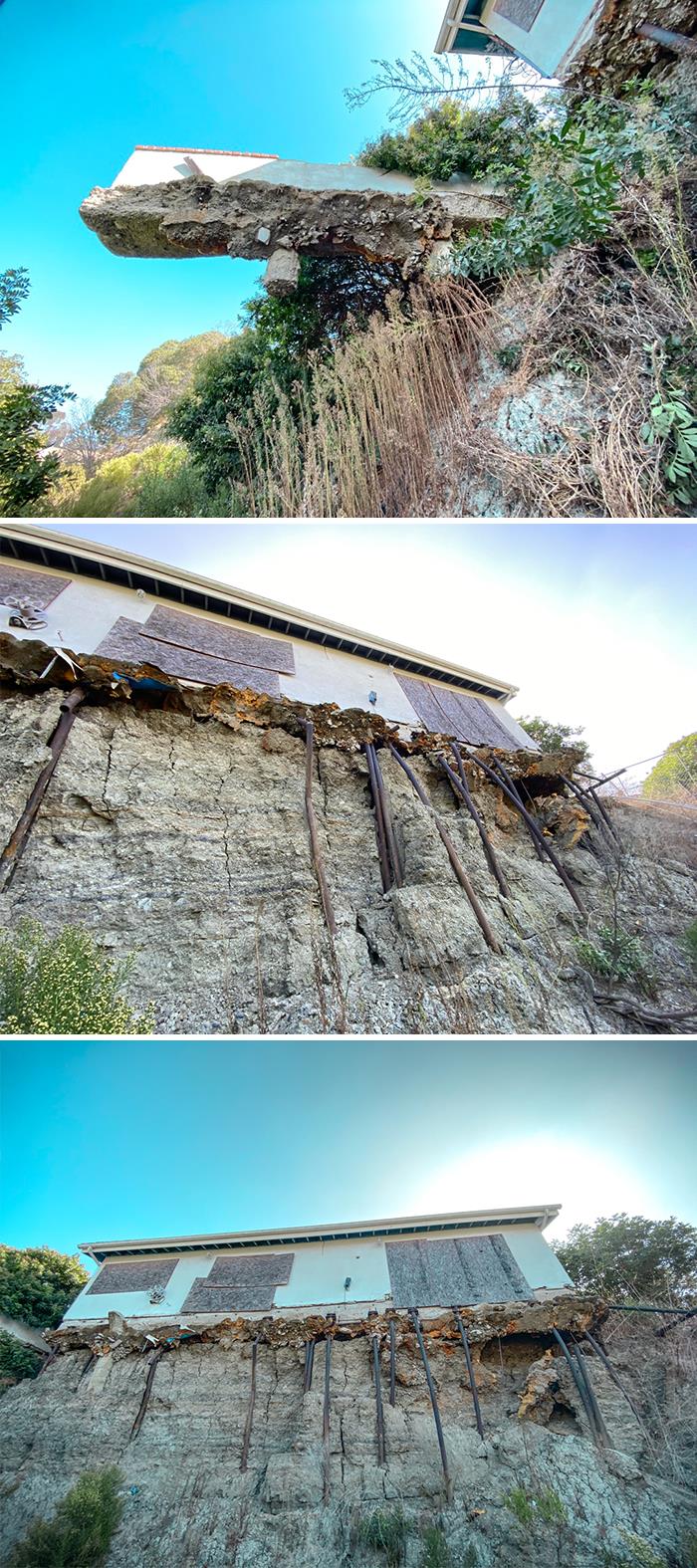
Image credits: AlphaStructural
#78
This post and pier looks funny.
Someone replaced the post with a game of jenga.
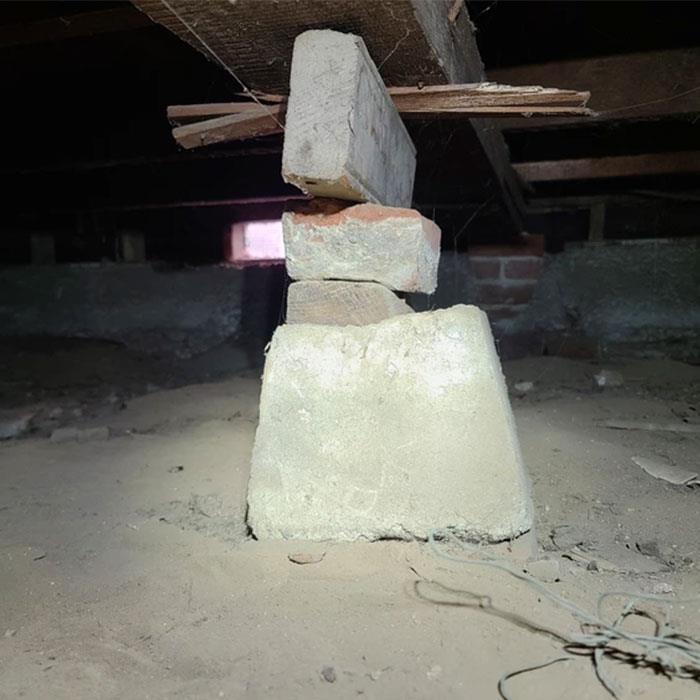
Image credits: AlphaStructural
#79
If you’re ever concerned about your slab foundation being cracked, look out for this
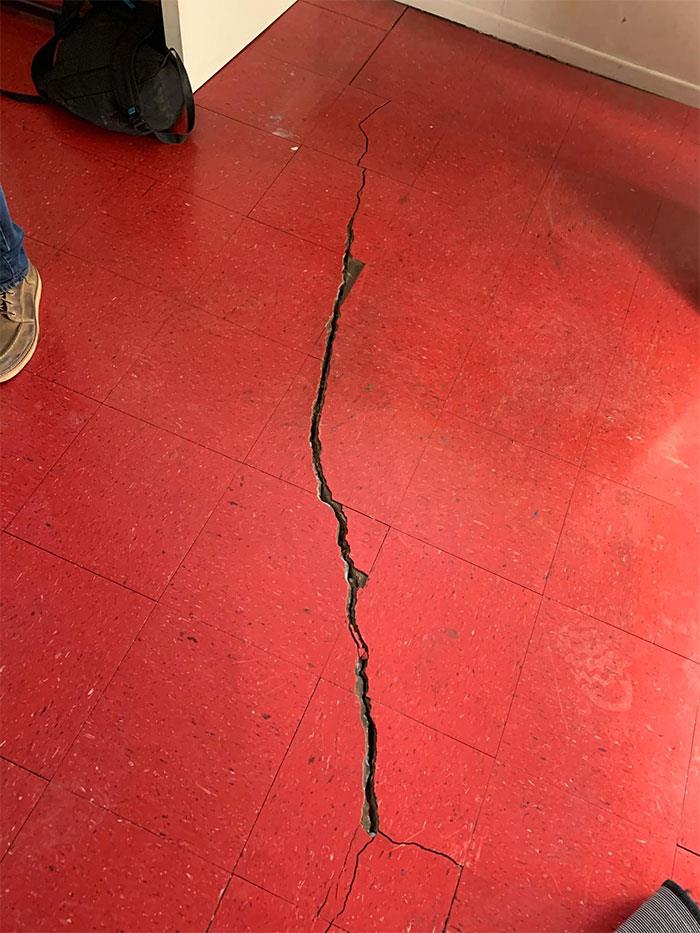
Image credits: AlphaStructural
#80
Only bounce houses should move side to side. This home’s garage is clearly on its way out. Hope it’s empty.

Image credits: AlphaStructural
from Bored Panda https://ift.tt/qtrhVnO
via IFTTT source site : boredpanda